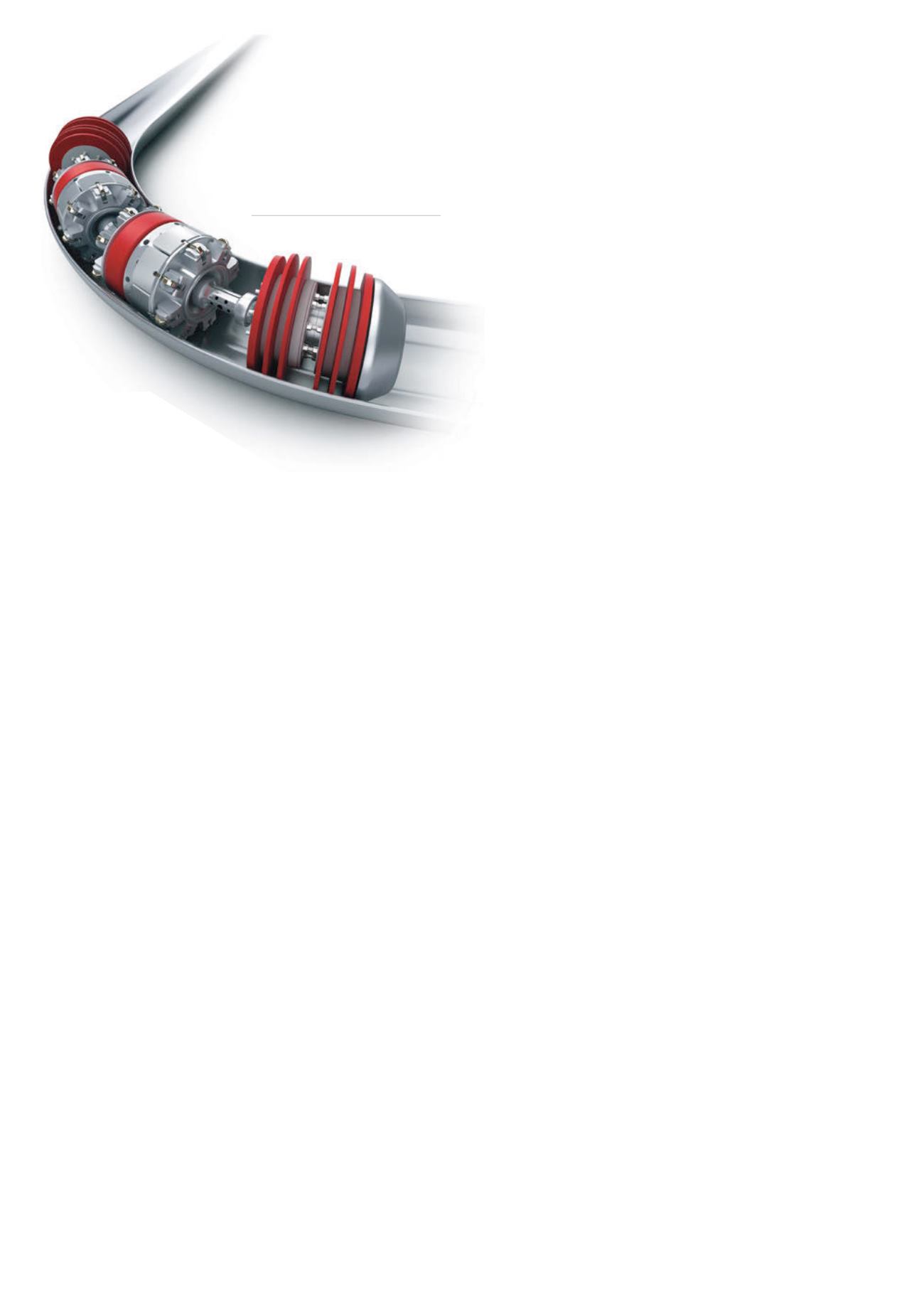
tie-ins to new
lines, hydro-testing
of sections of new line
and mid-line repair work.
Central to the success of this
isolation method is the SmartPlug® tool, the first tetherless
pipeline pressure isolation system to be operated remotely.
Designed by global pipeline services provider T.D. Williamson
(TDW), the system is a double-block pressure isolation system that
is bi-directionally piggable and capable of navigating 3D bends. This
isolation technology, certified by Det Norske Veritas (DNV), is rated
for 200 barg (2900 psi) working pressure and is typically designed
as dual module.
The SmartPlug tool is operated and monitored entirely by
remote control using the SmartTrack™ system, which transmits
commands and receives pipeline and operational data through the
pipe wall. Whether the SmartPlug tool is inserted into a subsea,
topside or onshore pipeline, the SmartTrack system pinpoints its
location, identifies it via a unique identification code attached to the
SmartPlug tool’s transponder and monitors the pipeline pressure.
Should an unplanned stop of the isolation tool occur, the location is
quickly communicated so that immediate steps can be taken.
After the isolation tool is pigged into position and set, one
section of the isolation is depressurised while the other section
of the pipeline maintains pressure and production. Work on the
pipeline is then performed at ambient pressure. Should more than
two production facilities be connected to the same pipeline, this
isolation method allows work to be performed on the pipeline at
one facility, while the other remains at full production.
To appreciate the benefits and ease with which the isolation
tool is used, the following operations in Malaysia and Norway
demonstrate how isolating the line makes it possible for such
critical work to be carried out.
Secure isolation facilitates safe hydro-testing in
Malaysia
Although the pressure isolation method is used primarily to
facilitate pipeline repair, maintenance and tie-ins to new pipelines,
it also plays a key role in precommissioning new lines. To illustrate,
TDW recently completed a pressure isolation operation on a
major export gas pipeline offshore Malaysia, during which the
pipeline was hydro-tested and made ready for commissioning.
The isolation was carried out on a newly installed subsea
pipeline between the floating production system (FPSO) pipeline
end manifold (PLEM) and a key gas complex, located approximately
240 km (149 miles) offshore Terengganu, in the South China Sea.
The complex features a production platform, riser platform
connected to the production platform by bridge, vent bridge and
vent boom.
The gas export pipeline designated for isolation stretches
53 km (32 miles) from a primary platform to a PLEM attached
to the FPSO. As part of the precommissioning project, it was
necessary to hydro-test the 16 in. gas export pipeline that stretches
from the platform to the FPSO PLEM. This had to be completed
following the pipeline spool and PLEM installation, but prior to
the dewatering and drying operation. The operator specified the
SmartPlug isolation tool to create an isolation in the PLEM. The
tool was to be used to maintain the pressure rate between the
riser and the PLEM, while the pipeline was being tested, in order
to prevent testing pressures from occurring at the site of the three
open ball-valves in the PLEM.
The key objective was to provide the operator with an
isolation solution whereby the entire line, from the platform to
the subsea PLEM, could be hydro-tested, with the exception of
the three open ball-valve sites in the PLEM which had been tested
previously.
With just three months to prepare and execute the operation,
TDW drew upon the expertise of its engineers and technicians in
Malaysia, Australia and Norway.
The targeted section was isolated by launching the remotely-
operated SmartPlug tool from a temporary subsea launcher,
moving it 7 m (22 ft) into the pipeline through the main PLEM
valve, before setting it. TDW isolated the section of the PLEM,
while the 16 in. gas export line was hydro-tested to a pressure of
188 bar (2726 psi) for 24 hours. Throughout the operation, TDW
used the SmartTrack system to enhance control during launching,
pigging, setting, pressure monitoring, unsetting and retrieval of the
SmartPlug tool.
With the PLEM securely isolated, the operator could safely
hydro-test the export gas pipeline, confident that it would
complete the critical phase, safely and reliably.
While this application is useful for the precommissioning
sector, a great majority of isolations are carried out to remove and
replace defective valves.
Swift valve replacement offshore Norway
Replacing pipeline valves is commonplace in the pipeline
maintenance world. It is so predictable that a major operator in
Norway, renowned for its dedication to emergency preparedness,
has made valve replacement an essential element of its
comprehensive emergency pipeline repair system (EPRS).
Why does this operator go to such lengths? A case in point:
when engineers discovered a defective valve on a 36 in. dry gas
pipeline attached to a riser platform in the Norwegian sector
of the North Sea, gas production was halted. But not for long.
Because the operator shares a frame agreement with TDW to
provide pipeline pressure isolation services when repair work is
required, the two companies are prepared to move quickly. Pre-
engineering was complete, and specialist pipeline pressure isolation
equipment and an experienced crew were on-hand, ready to
respond, saving time and money.
In this particular instance, TDWwas retained to provide a 36 in.
SmartPlug isolation to create a safe environment while the valve
was replaced.
92
World Pipelines
/
SEPTEMBER 2014
Figure 2.
With the remotely
operated SmartPlug
®
pipeline
pressure isolation tool, a safe
work zone is created while
valves are replaced, new
sections constructed, tie-ins,
and hydro-testing of new lines
takes place.


